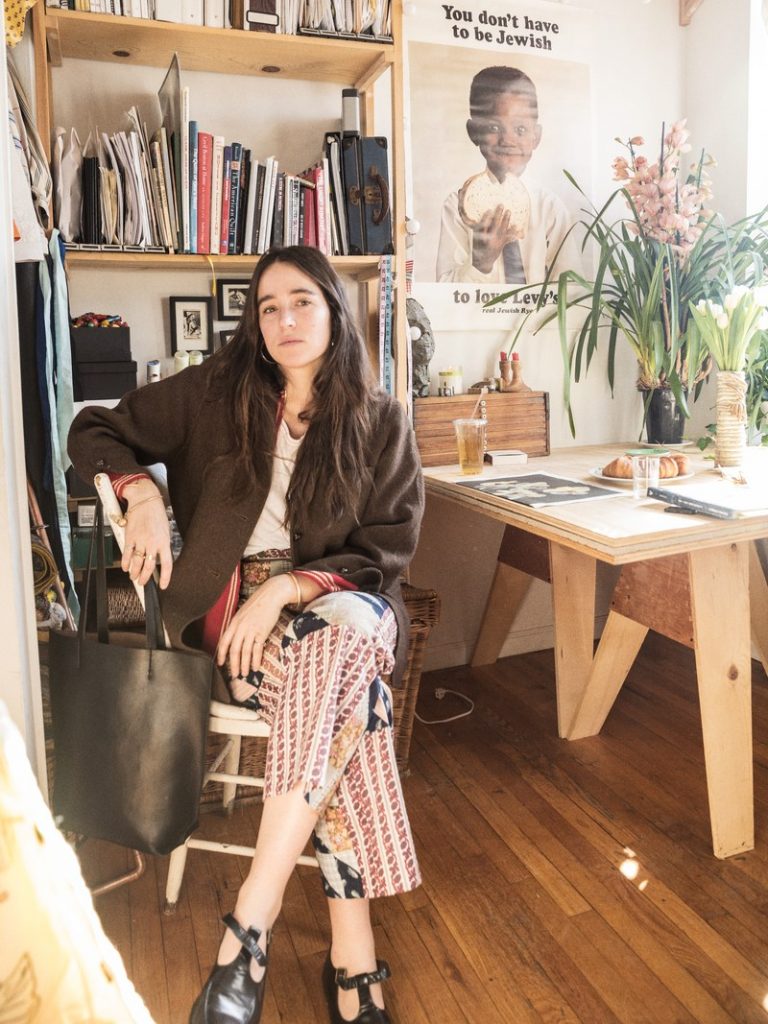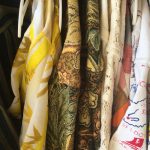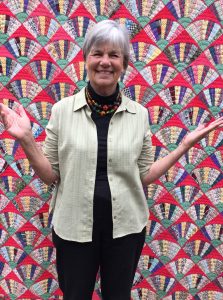In the lecture that we give as part of our Quilt Story Road Show program, we share our Top Five Reasons You Should Label Your Quilt. One of those reasons is “For your family: because a quilt can’t speak for itself, and it might outlive you.” More and more often though, we hear a common refrain, “What if my family doesn’t want my quilts? Then what? Who will want them and appreciate them?”
In an effort to dig into this question, we asked quilt historian Merikay Waldvogel of Knoxville, Tennessee to write our first post of a blog series we’re calling The Next Quilt Keepers. Merikay recently interviewed fashion designer Emily Bode who uses salvaged quilts in her menswear pieces. Join or renew your membership with the Quilt Alliance to watch StoryBee episode 3, featuring Emily Bode interviewed by Merikay Waldvogel (watch at the end of this post).
The Next Quilt Keepers:
Quilt Historian Meets Fashion Designer
by Merikay Waldvogel
First, I saw photos of Kardashian women lounging on bright red-and-white pieced quilts inside a barn. Calvin Klein was advertising his spring line in Manhattan this spring. I wasn’t sure what the quilts, the barn or the Kardashians had to do with selling clothes, but they sure got my attention.
More than one designer used quilts this spring, and I wasn’t the only quilt historian who cringed. Haven’t we been down this road before. Why do quilts have to be destroyed for the sake of design, marketing or shock value?
And then I read about 28-year-old fashion designer Emily Bode in GQ Style Magazine: “Bode is winning the New York Fashion Race with Quilts (Yes Quilts). She is turning rare and forgotten textiles into workwear you’ll want to start collecting.” She’s designing clothes for men (Yes Men) with quilts!

Emily Bode in her Lower East Side apartment-turned-showroom. Photography: Matt Martin for GQ Style Magazine.
I wasn’t sure why I wasn’t as upset this time. I shared my feelings with Amy Milne (Quilt Alliance executive director). She, too, had seen the article and Bode’s line of menswear. Visit Bode’s website to see for yourself. My husband wouldn’t wear such outfits, but Amy’s teenage son might. We all thought they were original and refreshing.
I jumped at the chance to interview Emily Bode for the Alliance’s StoryBee project. How cool! We would do it using the video camera on our iPhones! What questions would I ask her? I invited my quilt friends to suggest some questions.
One friend groused, “She doesn’t want to hear my opinion. I wouldn’t be caught dead in one of her jackets.” Another friend gave me my best question, “How do you see yourself as being different from others who are using the quilt theme in their fashions?”
For all quilt lovers, the big question was “Why cut up quilts?” The more I considered that question, the more I stumbled upon the irony of quilts themselves being made from cut-up textiles, clothing, bed linens, salesmen samples, feed sacks and aprons.
I think our unease has to do with the fact that quilts, for the most part, are anonymous. The fact that the quilt remains in relatively good shape is a testament to the work of the quiltmaker. And who are we to cut it up, to end its use? I knew I would have to ask her that question.
She had heard the criticism before. She responded that some quilts in jackets that people are most upset about were made by quilters on her staff. When she must “repurpose” a vintage quilt, she does her best to record its history, pattern name, and age on the garment tag. She even hopes to embed the history in some sort of barcode for the buyer to keep. She won my heart with this answer. This is exactly what the Alliance has advocated for since its inception. Save the stories in any way possible.
I asked her why quilts this year seem to be popular and how long she plans to use vintage fabrics and quilts. She told me what she is doing differently is that she is building her Bode menswear brand around repurposing vintage fabrics and needlework. Hers is not an advertising ploy. The various colors, patterning, surface embroidery and even repairs will determine the look of the line from season to season.
Then my mind started spinning? If she is going to flourish and have multiple garments sold in stores, where will she find enough quilts, crocheted items, needlework, and quilt tops. She told me that one cut-up quilt or top doesn’t make more than three jackets. She shops online and at antique markets for textiles, but one particular dealer in New England looks for things Emily might like. She told me she was on her way to India to check out warehoused bolts of fabrics—”deadstock” she called it. “Sometimes we are lucky and find a few pieces of 1920s or 30s fabrics. Usually, it’s 1980s fabrics which is just fine,” she said.

Finished Bode pieces hanging in the studio, including mens shirts and jackets. Photo: Quilt Alliance.

Fabrics include vintage terrycloth, cotton Quaker lace and French linen. Photo: Quilt Alliance.
Hmmm, I thought – 1980s fabrics? This might be the answer to a problem we fabric hoarders have! We could all ship her boxes of fabrics, unfinished projects, quilt blocks and tops, or even crocheted items. She smiled when I made the suggestion but didn’t reject the idea outright. She does seem to have plenty of “materiel” already.
Before I got carried away with my “brilliant” idea, I wondered if she really knew the difference between a quilt to save and a quilt to repurpose. She convinced me when she talked about hand-made quilts with lots of quilting. Listen to her answers.
In conclusion, this seventy-year-old quilt historian is glad to have met twenty-eight-year-old fashion designer, Emily Bode. I came away from the interview with a smile on my face. This young woman has found her voice and found her brand. Her journey has not been long but she seems to know where she’s going. I learned what she values, how she creates and what it takes to produce a fashion line.
I may not ever wear a jacket made of an 1880s Log Cabin quilt no matter how distressed it, but in the hands of Emily Bode, our quilts and their stories are resonating once again in this modern world. And like the repair to broken Japanese pottery known as “kintsugi,” in this case, the re-purposing may result in something not only longer- lasting, but also more artistic than the original.

Merikay Waldvogel
Merikay Waldvogel, one of the key players of the late 20th century quilt history revival, has served on the board of directors of both the American quilt Study Group and the Quilt Alliance. She has been involved in a number of QA projects including: The Quilt Index, Boxes Under the Bed, Quilt Treasures, and QSOS.
Her quilt journey began with the purchase of one quilt in Chicago that touched her heart even though she knew nothing about its maker or the circumstances of its making. A few years later in Tennessee, she co-directed the Tennessee Quilt Survey in the 1980s, and began writing and lecturing about women and their quilts. She has written several books including: Quilts of Tennessee, Soft Covers for Hard Times, Patchwork Souvenirs of the 1933 World’s Fair, Southern Quilts of the Civil War, and Childhood Treasures.

Great job Merikay!
I love the idea that she is somehow making the effort to add the story of the quilt’s history to the label! I buy sections of old cut up quilts when I find them to add to my collection as study pieces. At my age it is much easier to travel and lecture with blocks and segments than to lug all full-size quilts around. I know some don’t agree with this but it is a fact of life in our modern society that old quilts are getting cut up and repurposed. It’s been going on for at least 35 years. It took me awhile to get there too. My hope is that folks seek out those with knowledge of old quilts to ask “is it Ok to cut this one up” before they cut. But I know that is probably wishful thinking on my part.
What a great way to reduce your lecture kit load, Karen! Thank you for commenting. I think this is a tough idea for many quilt lovers to accept, and your opinion may help others reconsider. We wanted to share Emily’s story because we feel she is very thoughtful and responsible about the way she uses quilts and pieces of quilts in her fashion business.
I saw a welk-made mediun- large teddy bear well made from party of an old quilt with some “distressed” spots showing in the teddy bear. I thought it was awful to cut into a quilt.
After that, my mother made a machine stitched quilt for each of her children and a double wedding ring quilt for a granddaughter’s wedding gift. My attitude changed after my quilt had been in constant use for around 30 years. The fabric split at seams that got the most wear. The fabric wouldn’t stand up to much more use. Mom had used a blouse weight cotton instead of a heavier weight weave for a more durable quilt. Suddenly I understood that a teddy bear or small accent pillows cover let’s the treasure be seen and loved anew. My quilt is stored out of sight. I could hand stitch it to a strong linen backing for use as a wall hanging with decorative curtain rod. But that lightweight cotton won’t be strong enough for teddy bears, accent pillows or quilt jackets.
Thanks for sharing your perspective, Sue. Great point about materials used relative to the lifespan of a quilt.